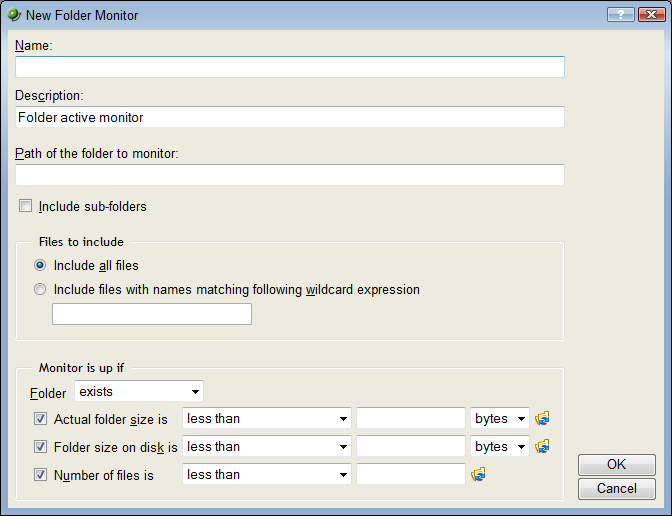Using the Folder Monitor
This monitor checks that a local or network share folder meets the conditions specified in the monitor configuration. For example, you can monitor folders for the existence of specific files, whether a folder exists, when a folder size is greater than or less than a specified size, when the number of files in a folder is greater than or less than a specified number of files, and more.
Note: The Folder Monitor only checks folders local to a machine on which WhatsUp Gold is installed, or folders on a network share accessible from the WhatsUp Gold device.
Note: This monitor uses the Windows credentials assigned to the device.
To configure a Folder Monitor:
- Go to the Active Monitor Library.
- From the web interface, click GO. The GO menu appears.
- If the WhatsUp section is not visible, click WhatsUp. The WhatsUp section of the GO menu appears.
- Select Configure > Active Monitor Library. The Active Monitor Library appears.
- or -
- From the main menu bar of the console, select Configure > Active Monitor Library. The Active Monitor Library appears.

- In the Active Monitor Library, do one of the following:
- Click New. The Select Active Monitor Type dialog appears.
- Select Folder Monitor from the list, then click OK. The Add Folder Monitor dialog appears.
- or -
Select an existing Folder Monitor, then click Edit. The monitor properties dialog appears.
- Enter or select the appropriate information in the following fields.
- Name. Enter a title for the Folder monitor as it will appear in the Active Monitor Library.
- Description. Enter a short description for the monitor as it will appear in the Active Monitor Library.
- Path of the folder to monitor. Enter the Universal Naming Convention (UNC) file path that WhatsUp Gold will use to access the file. For example:
\\192.168.3.1\website\product\Note: Local folders and folders on mapped drive paths are not permitted for the File Properties Monitor. Only UNC paths are allowed.
- Include sub-folders. Select this option to include all folders within the parent folder in the monitor scan.
Important: Selecting this option can greatly increase the amount of time it takes to complete the monitor scan and possibly have an adverse affect on WhatsUp Gold performance.
Files to include
- Include all files. Select this option to include all files within the parent folder in the monitor scan.
- Include files with names matching following wildcard expression. Select this option, then enter a wildcard expression. Files that match the wildcard expression will be included in the monitor scan. For example, enter
*.exeto check for executable (.exe) files in the selected folder.Note: This option only works for a single wildcard expression at a time. If you enter more than one expression, the monitor reads the entry as one wildcard expression.
Important: When enabled, this option has the probability to greatly slow WhatsUp Gold performance, dependent on the wildcard expression specified. The probability of slower performance increases when this option is used in conjunction with the Include sub-folders option.
Monitor is up if
- Folder. Select the appropriate option: exists or does not exist. If you select exists, the monitor is up if the selected folder is found. If you select does not exist, the monitor is up if the folder is not found.
Note: The following options are not required for the monitor scan.
For the following options, select the appropriate variables to determine the success or failure of the monitor scan:
- less than
- less than or equal to
- greater than
- greater than or equal to
- equal to
- not equal to
- Actual folder size is. Select this option to make the monitor dependent on the actual folder size. The default unit used for the folder size is bytes. Optionally, you can change the unit to either KB, MB, or GB.
- Folder size on disk is. Select this option to make the monitor dependent on the folder size on the disk. The default unit used for the folder size on disk is bytes. Optionally, you can change the unit to either KB, MB, or GB.
- Number of files is. Select this option to make the monitor dependent on the number of files in the folder.
Tip: To obtain the current actual folder size, folder size on disk, and number of files, first select the appropriate option, then click the folder properties button. These current values will populate the option value field and can be used to set the monitor threshold.
- Click OK to save changes.